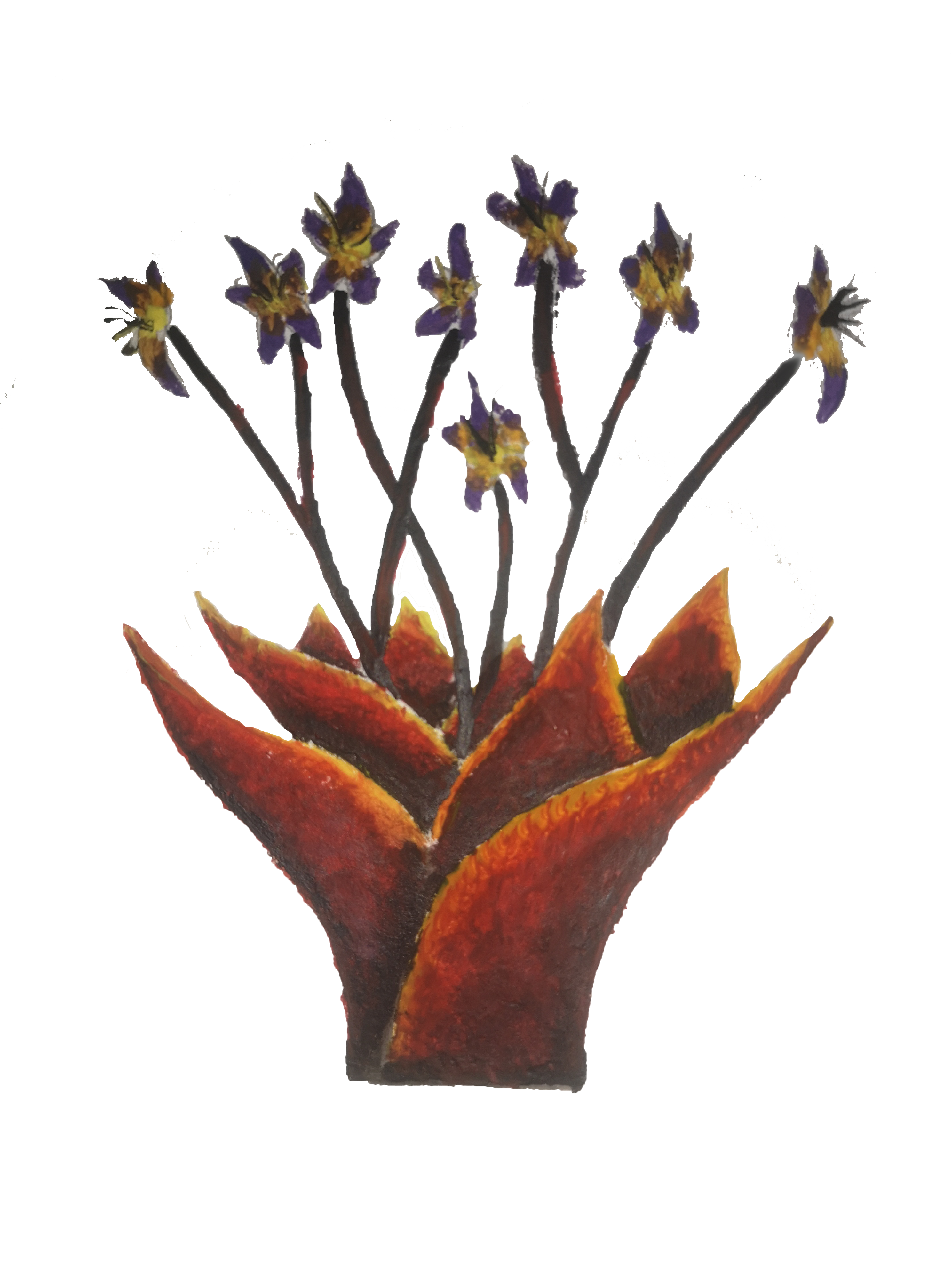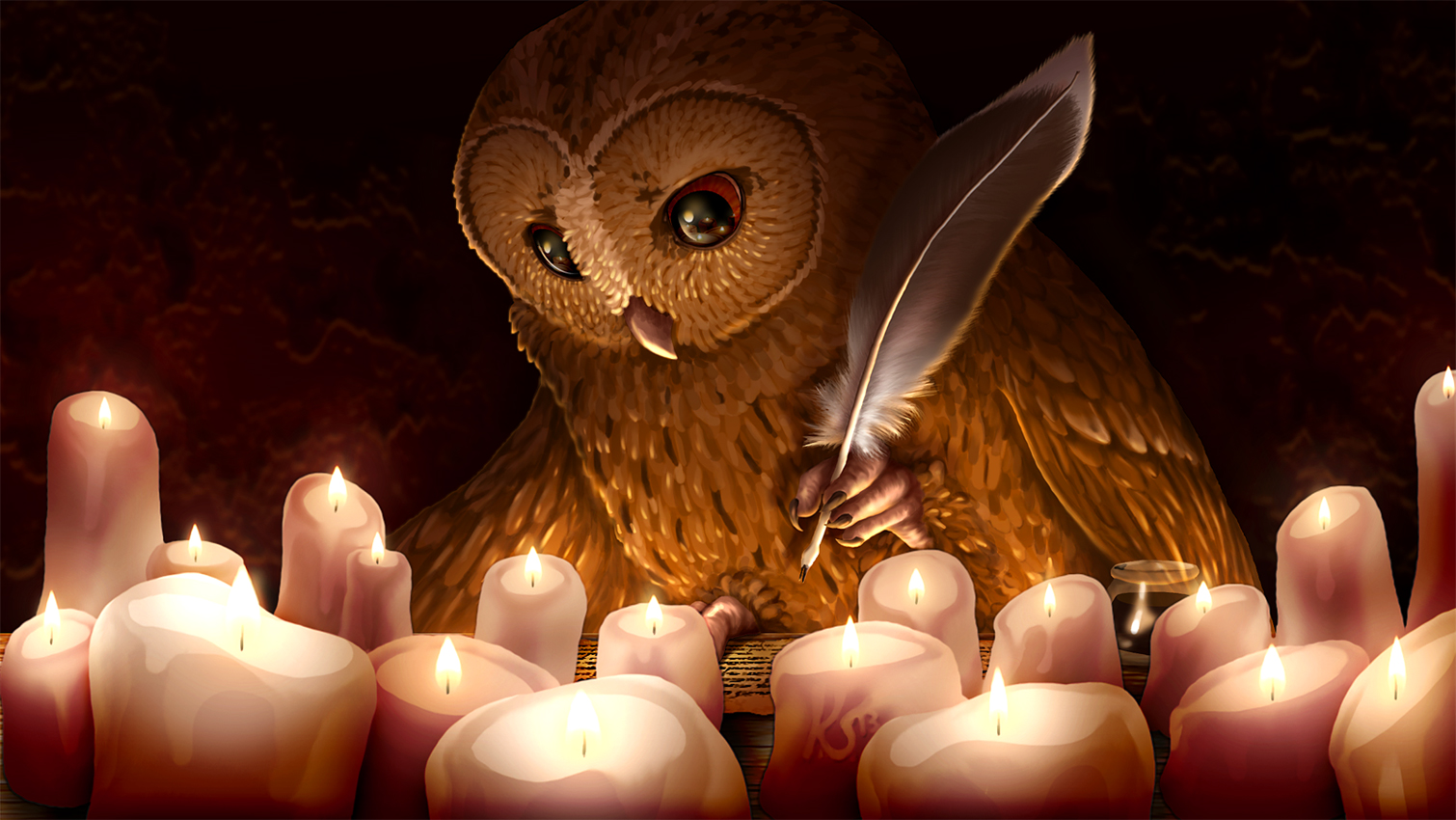Corpse Blossom
I fear the day that I may die.Corpse Blossom is a flowering plant found across the continent of Alvania. They are easily recognisable by their blood-red leaves and ornate orange and purple flowers. The flower is often found growing in areas where a large amount of death has occurred, with seeds only germinating if they are exposed to corpses be that humanoid or animal, hence the plant's name. The plant also, if left to grow and seed, is able to cause any nearby dead to reanimate. This is due to the Black Lemirus that grows in its root system. Due to this, controlling the growth and spread of the plant is an important part of everyday life for many settled people in Alvania.
I fear the world I will leave behind.
To die in battle is to be consumed
by the corpse flower that does bloom
In the fields of restless dead
leaves will sprout of crimson red
and soon the dead will rise once more
to carry on eternal war
Properties
Description
The base of the plant is a rosette of blood-red leaves that grow lighter towards the edges. The rosette itself ranges from 12-25 cm across. From this rosette grows between 6-12 flowers with the flowers able to grow up the 50cm high in some sub-species.
The stems of these flowers are of similar colouration to the rosette. The petals of the Corpse Blossom vary from species however the most common colouration is orange/purple with these petals then being arranged with 3 large petals in a triangular separation with 5 smaller petals framing them from behind.
The flower blooms about 2 weeks after germination occurs with the subsequent distribution of seeds and death occurring anywhere between a week and a year, depending on the concentration of necrotic energy in the vicinity of the plant, with higher concentrations increasing the speed at which the seeds form.
Damaging the plant will cause it to release a blood-like substance that can cause necrosis of any flesh it comes into contact with. On top of this, the plant also produces a cloud of powerful paralytic dust that is periodically released from the flowers which can cause death if exposed to for too long.
The known sub-species of Corpse Blossom are as follows:
- Common/Field - the most common form of Corpse Blossom found across the continent
- Pygmy - a rare subspecies which is often found in caves and barren areas where organic matter is less available
- Thorned - located in the colder northern regions this subspecies is distinguished by the thorns located around the plant's rosette
- Desert - this subspecies has much smaller flowers and leaves but a much stronger paralytic dust
Reproduction
The Corpse Blossom has a unique life cycle due to the fact that seeds require a fresh corpse (humanoid or animal) to begin growing and produce seeds not from cross-pollination with other plants but by absorbing the necrotic energy that the corpse gives off as the plant feeds on it. When the seeds have been produced they explode out from pods that form on the flowers in all directions. If these seeds land in any fresh corpses the cycle continues. However, if they land in a more decomposed corpse they will animate instead causing it to become an undead. This undead is then drawn to decay and death as well as the living where it will explode, not only spread the seeds but also a large cloud of dust designed to kill anything nearby, providing the seeds with fresh corpses to grow in.Magical properties
Shambling Corpse Blossom
In some cases if a sufficiently large amount of Corpse Blossoms are located in the proximity of one another the resulting mass of Black Lemirus results in the creation of a semi-sentient plant monstrosity. When this happens the various plants will send out tenrdrils to one another and pulling together into a singular mass. This creature can vary greatly in size however most reports talk of 'Shamblers' being the size of bears. However, legends have mentioned creatures of this nature growing to the size of buildings as they consume more and more corpses.As the Shambling mound of corpse blossoms grows its dust becomes more potent, its intellect increases and it can even gain new appendages and abilities depending on the nature of the corpses it consumes. Due to this any reporting of Shambling Corpse Blossoms are dealt with incredibly quickly with a large amount of effort put in to ensure that new ones cannot form.
Culture and History
uses
Corpse Blossom can have a number of materials extracted from them. Most uses of the plant are derived from either the dust it's flowers' potent dust or the Lemirus that grows in the roots. However, the seeds can also be used to create an oil which highly prized for its ability to clear out wounds.Medicine
As mentioned before the seeds of the Corpse Blossom can be used to create an oil that can clean wounds of dead tissue as the oil will dissolve any necrotic tissue. Along with this the paralytic dust can be mixed and diluted to create a powerful painkiller that is used by many nobles during childbirth.Dye
The petals of the Corpse blossom can be ground to create rich dyes which can then be applied to clothing. This practice is reserved though to those of the 'necromancy' school of magic or those who work with the dead. This is not only due to the difficulty of procuring the dye but also due to fact that these groups are the main cultivators of the Corpse Blossom. The Dye can also be used in tattoos. However similar restrictions apply in most cases. It has been known for Thaumen to use this dye in their Birthday Rite especially those who work with the dead or have had strong events associated with the dead happen in their life.Drugs
A stronger version of the painkiller can be made from the dust of the Corpse Blossom. This can then be consumed in a number of ways and is known as Farthin, which is derived from the old word for corpses. Another drug that can be produced from the plant is Black Venom which is a magical substance created by mixing ground Lemirus crystals with the aforementioned Farthin. This combination gives the user not only a powerful hallucinogenic trip but also the ability to not die during its duration, however, wounds persist and many have been known to die after the drug wears off due to injuries sustained during its use.Arcane material components
The Black Lemirus found in the plant's roots can be used in a number of magical application. From powering rituals to supplying the energy needed to sustain undead summons. This is why some in the school of necromancy cultivate the plants they can have a small but steady supply of the magical crystal.Cultivation
While the plant is considered highly dangerous especially when found in large grouping due to the aforementioned shambling ability, there are still those who wish to extract the more useful substances from the plant. The most common cultivators are Gravekeepers who use the flower in order to clean fresh corpses. This is a task with risk however as leaving the plant unattended too long may cause an outbreak of undead if it is allowed to spread its seeds to any nearby dead. As such the right to own and cultivate the plant requires a licence in many parts of Alvania. Along with the grave keepers are necromancers who use the plant in order to gain access to the Black Lemirus that grows in the roots. Most cultivators of this nature use the corpses of animals in order to grow the plant however there are those that will use human corpses. Not only is this illegal, but it is also frowned upon by many practitioners of necromancy as it fuels the suspicion that surrounds their school of magic.History
Corpse Bloom has been present in Alvania since the first people were forged by the Gods. However, its cultivation and use as both a medicine and drug have only started in the last 200 years since the Thaumen refugees arrived. They quickly found not only the uses of the plant but also an effective way to safely grow it which minimised the risk of undead outbreaks. This is mostly done by ensuring the flower never reaches its wilting faze, along with using specialised equipment to ensure that the paralytic dust does not affect the cultivator. These practices have since begun to be adopted by the local races of Alvania as more interaction and integration occurs between them and their new Thaumen neighbours.War and the dead
Corpse blossom thrives in areas where death has occured. One such place are battlefields, which to the corpse blossom is a feast waiting to happen. This is because Corpse Blossom seed can stay dormant for decades, waiting for fresh corpses to feed on. As such it is common practice for bodies to be collected quickly after battles are burnt to ensure that Shambling Corpse Blossoms cannot form. However, this is not always possible and in such cases battlefields become undead breeding groups which then have to be pacified with force.Some armies in Alvania are even known to use powerful fire magics after a battle to ensure the plant has nothing to feed on. However, it is more common for armies to have a short truce to collect the dead and dispose of them in a more dignified way.
Table of Contents
Ghouls Iris
Grave Rose
Widows Bouquet
Locations:
Alvania
Height:
20-50cm
Weight:
200-500g








This is a very interesting plant :D It's really interesting that people are willing to cultivate it and have found so many uses for it despite it being so dangerous – I really like the graveskeeper cultivating it! Here are the notes I took while reading (I pointed out typos while I was at it since you're still editing it): I think you need to add "table of content" as a heading above it " This is due to the Black Lemirus that grows in its root system." What is Black Lemirus? You need to add either a short explanation or a tooltip? Is it only human corpses or can it do the same with animals? What about insects? " from this rosette grows between 6-12 flowers" capitalisation missing In the description section I would add a space between the paragraphs. In culture and history you have some sections that don't have a space between the end of the section and the next subheading. " which higher concentrations increasing the speed at which the seeds form." That first "which" should be a "with". Some of your sentences are rather long and either miss some more commas or could be broken down into smaller sentences. " Common/Field - the most commhttps://www.worldanvil.com/world/b50dbe59-a2e4-4d77-a897-1f558261b846/summaryon" you have a link that slipped in the middle there " the plant also produces a cloud of powerful paralytic dust that is periodically released from the flowers which can cause death if exposed to for too long." I'm wondering about the effect of this dust. Do people become lethargic? Are they completely paralysed or just slow downed? I'm guessing the death is because the respiratory system becomes paralysed too, unless it has some other effects? In the second half of the reproduction section, the sentences could be polished a little bit as they're hard to read right now. " In some cases is a sufficiently large amount of Corpse Blossoms" "is" should be "if" " the resulting mass of Black Lemirus results in the creation of a semi-sentient plant monstrosity." Are all of the corpses and their plants physically linked together or is this a magical link? " along with this the paralytic dust" capitalisation missing. Coming back to the start, your quote in the introduction made me wonder about battlefield. Do people try to choose a place where there is no corpse blossom to fight or do they not care? Do they maybe deliberately choose to feed the plant to have the undead them wreak havoc on the enemy's side?
I highly recommend using the mention system to add those sweet sweet links because I too want to know about this Black Limerus and other things you've mentioned in this article, and it helps encourage readers to wiki-walk and explore your world! Amelie grabbed up the typos I was going to mention. I am loving this plant and how it has a benefit and a risk to having it cultivated. I am looking forward to seeing you write up more and look forward to how this or other articles develop!
I've added a link to an old article on Lemirus in general. However, it will probably be out of date from modern ideas that I have for the setting. Unfortunately, my style of worldbuilding often leads to lots of retcons and rewrites. But I am hoping to get back into it and create a more structured world. I'm glad you liked the article hopefully any more that I write will be as interesting
Thanks for spotting those rather embarrassing mistakes. Hopefully, they are all gone now. I've now linked the lemirus article to this one so that should provide some clarity in regards to that. I've added an additional paragraph at the end covering the effect in war as for you other questions I've tried to sprinkle those into existing sections
*Lyraine gleefully rubs her hands together* It's always fun to re-explore earlier worldbuilding efforts (I have a lot of old articles that are in dire need of rewriting myself) and to bring those up to your current worldbuilding styles.